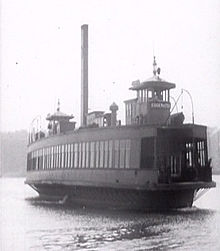Transport of New Jersey
This article needs additional citations for verification. (December 2018) |
| Transport of New Jersey | |
|---|---|
Tram and Bus | |
| Operation | |
| Began operation | 1917 |
| Ended operation | 1980 |
Transport of New Jersey (TNJ), earlier Public Service Transportation and then Public Service Coordinated Transport, was a
History
20th century


The Public Service Railway operated most of the trolley lines in New Jersey by the early 20th century. Public Service lines stretched from northeast New Jersey to Trenton, and then south to Camden and its suburbs. Major parts of the system were:[citation needed]
- The Newark Public Service Terminal, a two-level terminal in downtown Newark.
- The New Jersey Palisades into Jersey City and south to near Journal Square.
- The right-of-way from Newark to Trenton.[citation needed]
Public Service Transportation was formed in 1917 as a bus-operating subsidiary of the Public Service Corporation, supplementing the Public Service Railway's trolley lines. In 1928, the operations of the two companies were merged to form Public Service Coordinated Transport. Over time, Public Service
The name was changed to Transport of New Jersey in 1971. PSE&G sold TNJ to New Jersey Transit Corporation in 1980. Although PSCT/TNJ had been a major profit center for PSE&G earlier in the century, PSE&G had increasingly felt chagrin at having to retain unprofitable routes, and believed the state could provide better service. PSE&G chairman Robert Smith said that he and his colleagues felt they were "getting rid of a headache."[1] Many of former PSCT/TNJ bus routes are still run by NJ Transit and even use the same number.[citation needed]
Following bustitution, the only streetcar route still in operation was the #7 line, in the form of the Newark City Subway.
21st century
At the turn of the 21st century, the line was upgraded to operate new modern light rail cars, and was extended northward into Bloomfield. The system was renamed the
See also
References
- ISSN 0362-4331. Retrieved 2017-02-13.
External links
- York Times, July 11, 1904 Buys Kearny Meadows Tract: Trolley Company May Shorten Newark-Jersey City Route
- Historic American Engineering Record (HAER) No. NJ-65, "Public Service Railway Company, Newton Avenue Car Shops"
